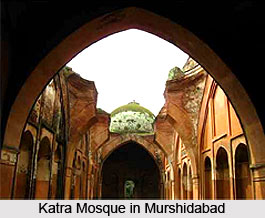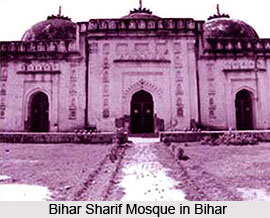Islamic art in Eastern India involves several monuments, mosques, buildings and other forms of art widespread in the Eastern Indian states of West Bengal, Bihar and Jharkhand. Islamic architecture has been existent in these potions since the era of the Delhi Sultanate, the Mughal Dynasty and thereafter. The settlement of Muslim rulers, Mughal kings and Muslim communities had encouraged many types of Islamic arts in these states. Therefore, Islamic art displayed in these regions belong to the ancient, medieval and modern ages. Tombs, `dargahs` and many other kinds of buildings are present as a testimony of Islamic art in Eastern India.
 Islamic Art in West Bengal
Islamic Art in West Bengal
The Gaur area of West Bengal possesses some of the most renowned masterpieces of Islamic art. Laltan Masjid in Gaur is considered the best instances of Islamic art in this state. The mosque`s front wall is adorned with colourful tiles and its prayer room contains a domed ceiling. The Qaddam Rassul Masjid located here consists of sloping eaves. Some Hindu temples situated here were inspired by the Islamic architecture and possesses octagonal pillars on the main entrance. Another impressive Islamic arts structure is the Katra Mosque in Murshidabad which was erected by Nawab Murshid Quli Khan. It is said that this mosque has been constructed as a replica of the Kaaba Mosque, Mecca and represents Islamic art in medieval India.
Adina Mosque and Eklakhi Mausoleum in Malda district and Tipu Sultan Mosque in Kolkata are amongst the numerable Islamic monuments in West Bengal. Eklakhi Mausoleum located in Hazrat Pandua, Malda is considered to be the tomb of Sultan Jalaluddin Mohammad Shah, the son of Raja Ganesha. This monument has curved cornices and terraces crowned with domes. The Tipu Sultan Mosque in Kolkata built by Tipu Sultan`s youngest son, Prince Ghulam Mohammad and Nakhoda Mosque in Chitpore Road, Kolkata are among the other notable Islamic art features.
 Islamic Art in Bihar
Islamic Art in Bihar
The Mughal emperor Shah Jahan is believed to have constructed a court in Rajmahal area of Bihar during his reign. He is known to have built several famous Islamic buildings in this state. In 1628, Shah Jahan had constructed an `Idgah` when he was the governor of Bihar. Among the pre-Mughal Islamic art forms, the Hajipur Jami Mosque and Farid Bukhari`s Bihar Sharif Mosque are quite reputed. Saif Khan, one of the agents of Shah Jahan had built a `madrasa` or school under the regime of this Mughal ruler. It is located on the back of River Ganga and imparted education to over 100 students. The city of Patna boasts of a number of mosques situated along the bank of River Ganga. The mosque of Hajji Tatar built by Shah Jahan is the best known demonstration of Islamic art in Bihar. Beautifully carved black stones have been employed in the arches of this mosque. Habib Khan`s mosque made in 1638 near Bihar Sharif is another excellent Islamic art form here. The mosque of Raja Bahroz constructed under the rule of Shah Jahan is amongst the many Islamic monuments which have been influenced by those in Bihar Sharif.
Islamic Art in Orissa
Islamic art in Orissa made its advent in Orissa with the arrival of the Mughals and Afghans in this part of the country. Therefore innumerable Islamic architectural shrines are deft instances of architectural brilliance of Islamic arts in Orissa. Maximum number of these monuments is based in the city of Cuttack. Built in 1636, Lal Bagh Palace was a major palace meant for Mughal governors. Dewan Bazar Mosque located at Cuttack is believed to be the oldest mosque of Cuttack. The Juma Masjid of Balu Bazar, Fateh Khan Mosque, Mohammadia Bazaar Mosque, Qadam Rassool and Sardar Khan Bazaar Mosque are a few of the most illustrious elements of Islamic arts in Orissa.
The eastern parts of India comprise multiple forms of Islamic arts which reflect the tastes of the medieval Islamic rulers in India.



















